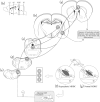Evidence for chronic headaches induced by pathological changes of myodural bridge complex
- PMID: 38438423
- PMCID: PMC10912660
- DOI: 10.1038/s41598-024-55069-7
Evidence for chronic headaches induced by pathological changes of myodural bridge complex
Abstract
Clinical studies have shown that there may be a certain relationship between pathological changes of the myodural bridge complex (MDBC) and chronic headaches of unknown cause. But there is still a lack of experimental evidence to explain the possible mechanism. This study aims to further confirm this relationship between MDBC and chronic headaches and explore its potential occurrence mechanism in rats. Bleomycin (BLM) or phosphate-buffered saline (PBS) was injected into the myodural bridge fibers of rats to establish the hyperplastic model of MDBC. After 4 weeks, the occurrence of headaches in rats was evaluated through behavioral scores. The immunohistochemistry staining method was applied to observe the expression levels of headache-related neurotransmitters in the brain. Masson trichrome staining results showed that the number of collagen fibers of MDBC was increased in the BLM group compared to those of the other two groups. It revealed hyperplastic changes of MDBC. The behavioral scores of the BLM group were significantly higher than those of the PBS group and the blank control group. Meanwhile, expression levels of CGRP and 5-HT in the headache-related nuclei of the brain were increased in the BLM group. The current study further confirms the view that there is a relationship between pathological changes of MDBC and chronic headaches of unknown cause. This study may provide anatomical and physiological explanations for the pathogenesis of some chronic headaches of unknown cause.
Keywords: Bleomycin; Chronic headache; Myodural bridge; Myodural bridge complex; Referred pain.
© 2024. The Author(s).
Conflict of interest statement
The authors declare no competing interests.
Figures




Similar articles
-
The relationship between compensatory hyperplasia of the myodural bridge complex and reduced compliance of the various structures within the cranio-cervical junction.Anat Rec (Hoboken). 2023 Feb;306(2):401-408. doi: 10.1002/ar.25040. Epub 2022 Jul 21. Anat Rec (Hoboken). 2023. PMID: 35808865 Free PMC article.
-
An anatomical study of the suboccipital cavernous sinus and its relationship with the myodural bridge complex.Clin Anat. 2023 Jul;36(5):726-736. doi: 10.1002/ca.24048. Epub 2023 Apr 25. Clin Anat. 2023. PMID: 37096831
-
Utilization of MR imaging in myodural bridge complex with relevant muscles: current status and future perspectives.J Musculoskelet Neuronal Interact. 2020 Sep 1;20(3):382-389. J Musculoskelet Neuronal Interact. 2020. PMID: 32877974 Free PMC article. Review.
-
Magnetic resonance imaging-based classification of the myodural bridge complex and its influencing factors.Surg Radiol Anat. 2024 Feb;46(2):125-135. doi: 10.1007/s00276-023-03279-5. Epub 2024 Jan 9. Surg Radiol Anat. 2024. PMID: 38194160 Free PMC article.
-
Neural Plasticity in Common Forms of Chronic Headaches.Neural Plast. 2015;2015:205985. doi: 10.1155/2015/205985. Epub 2015 Aug 20. Neural Plast. 2015. PMID: 26366304 Free PMC article. Review.
Cited by
-
Resveratrol ameliorates pathological fibrosis of the myodural bridge by regulating the SIRT3/TGF-β1/Smad pathway.Heliyon. 2024 Jul 19;10(15):e34974. doi: 10.1016/j.heliyon.2024.e34974. eCollection 2024 Aug 15. Heliyon. 2024. PMID: 39145011 Free PMC article.
References
-
- Headache Classification Committee of the International Headache Society (IHS) The International Classification of Headache Disorders, 3rd edition. Cephalalgia38, 1–211 10.1177/0333102417738202 (2018). - PubMed
MeSH terms
Substances
Grants and funding
LinkOut - more resources
Full Text Sources
Medical
Research Materials

